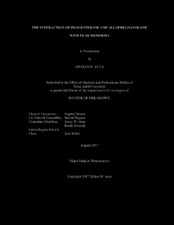| dc.description.abstract | Sex differences in stress and anxiety disorders are well reported in the clinical
population. For instance, women are twice as likely to be diagnosed with post-traumatic stress disorder (PTSD) compared to men. This difference is most profound during the reproductive years, suggesting a role for sex hormones and their metabolites in regulating fear and anxiety. Previous studies suggest sex differences also occur in rodents, which is modulated by gonadal hormones. Despite the majority of clinical cases occurring in women, most rodent studies only include male subjects. An understanding of what contributes to this disparity is necessary for sex-specific therapies and interventions. Here, we use Pavlovian fear conditioning, a learned task in which male rats display higher fear levels compared to females, to understand the neurobiological basis for sex differences in fear and anxiety. Specifically, we focus on allopregnanolone (ALLO), a metabolite of progesterone and potent allosteric modulator of GABAA receptors and its effects in the bed nucleus of the stria terminalis (BNST) in male and female rats. The BNST is a sexually dimorphic brain region and site of hormonal modulation that has
been implicated in contextual fear. Raising ALLO levels in the BNST of male rats
successfully impaired contextual fear and blocking ALLO in the BNST of female rats
successfully increased contextual fear. However, impairing contextual fear via ALLO in male rats proved to be the result of state-dependent learning, which was unique to the BNST as global impairments in both contextual and cued fear to ALLO were found in the basolateral amygdala. In females, hormonal changes across the rodent estrous cycle follow similar patterns to that of the menstrual cycle in women and provide a naturalistic model to observe changes in fear responses at the cellular level when ALLO levels are high or low due to progesterone fluctuations. Results suggest naturally circulating progesterone may also contribute to state-dependent contextual fear; however, ovariectomized rats administered progesterone do not. The work presented here aims to elucidate the mechanisms underlying ALLO’s influence on sex differences in fear and anxiety and contribute to the growing body of literature on women’s health | en |


